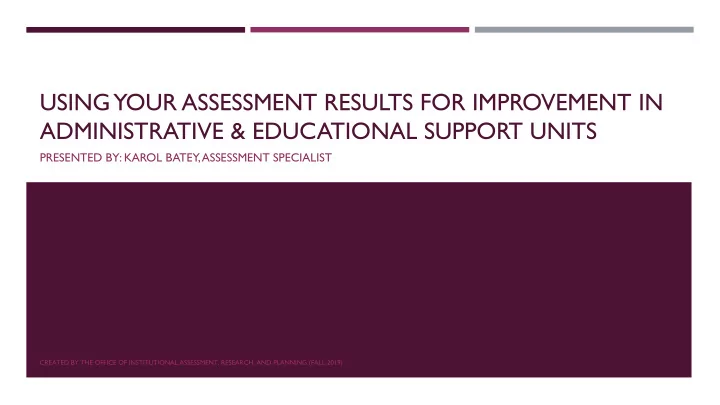

USING YOUR ASSESSMENT RESULTS FOR IMPROVEMENT IN ADMINISTRATIVE & EDUCATIONAL SUPPORT UNITS PRESENTED BY: KAROL BATEY, ASSESSMENT SPECIALIST CREATED BY THE OFFICE OF INSTITUTIONAL ASSESSMENT, RESEARCH, AND PLANNING (FALL 2019)
ASSESSMENT PROCESS We have previously learned about the planning, data collection, and reporting stages of the assessment process. Once you have completed these three stages now is the time for the most important stage of the assessment process. CREATED BY THE OFFICE OF INSTITUTIONAL ASSESSMENT, RESEARCH, AND PLANNING (FALL 2019)
USE OF RESULTS FOR IMPROVEMENT STAGE FOUR CREATED BY THE OFFICE OF INSTITUTIONAL ASSESSMENT, RESEARCH, AND PLANNING (FALL 2019)
WHAT DOES USING RESULTS FOR IMPROVEMENT MEAN? It involves administrators and staff working together to closely look at assessment findings and specify what improvements need to be made. The use of results also helps: 1) drive decision-making, 2) refine goals, objectives, and outcomes, and 3) improve the assessment process, if need be. The first step in using our results is to create your unit’s action plans CREATED BY THE OFFICE OF INSTITUTIONAL ASSESSMENT, RESEARCH, AND PLANNING (FALL 2019)
ACTION PLANS An action plan is the follow-up to the assessment just conducted. Actions must be identified for each objective, even if that action is to replace the objective with another one. Actions should also be as specific as possible, and should show that the team has thought through the results CREATED BY THE OFFICE OF INSTITUTIONAL ASSESSMENT, RESEARCH, AND PLANNING (FALL 2019)
EXAMPLES OF ACTION PLANS Process Changes Employee Support changing intake/communication procedures office retreat developing/revising forms professional development going electronic trainings/workshops creating work flow/charts technology assistance expanding a service Customer Service Changes eliminating redundancy developing communication protocols automated response/follow-up adding web-based services developing/revising handbooks/manuals CREATED BY THE OFFICE OF INSTITUTIONAL ASSESSMENT, RESEARCH, AND PLANNING (FALL 2019)
ACTION PLANS AND THE ASSESSMENT PROCESS A commonly reported use of results is to refine the assessment process itself: New or refined instruments Improved methods of data collection (instructions, incentives, timing, setting, etc.) Changes in participant samples CREATED BY THE OFFICE OF INSTITUTIONAL ASSESSMENT, RESEARCH, AND PLANNING (FALL 2019)
WHAT DO WE DO IN THESE SITUATIONS? Results are difficult to interpret Review the assessment method selected. It may be necessary to change the assessment instrument/tool (change the measure) Results can be interpreted but do not provide Additional measures may need to be added. It may be necessary sufficient detail to inform a meaningful decision to revise the measure to provide more meaningful information (i.e. change survey items). The target was not achieved Consider adding action steps (e.g., professional development, revision of course content) that increase the likelihood of attaining the desired outcome target. Adjust the target level if needed. Celebrate your achievement and determine if the target should Target was achieved be adjusted to a higher standard or if sustainability efforts should be put into place to maintain the level of performance noted. Consider removing the expected outcome from your IE plan Target is achieved consistently and replacing with another outcome and corresponding new (over more than one cycle) target
DOCUMENTATION If our activities/data/decisions/strategies and resulting changes for improvement are not documented… … then SACSCOC will think they don’t exist! CREATED BY THE OFFICE OF INSTITUTIONAL ASSESSMENT, RESEARCH, AND PLANNING (FALL 2019)
HOW TO DOCUMENT We focus on the unit Anonymity of all participants in our measures has to be maintained - never identify anyone Clearly state how findings were reviewed Clearly state the changes implemented as a result of the findings and who or whom will be implementing these changes CREATED BY THE OFFICE OF INSTITUTIONAL ASSESSMENT, RESEARCH, AND PLANNING (FALL 2019)
MOST IMPORTANTLY We need to use our findings to: Plan, Strategize, and Improve. All of this finishes our current cycle while simultaneously laying the foundation and groundwork for the next assessment cycle. CREATED BY THE OFFICE OF INSTITUTIONAL ASSESSMENT, RESEARCH, AND PLANNING (FALL 2019)
REFERENCES Baker, W. (2012). Assessment 101: Non-Academic & Co-Curricular Assessment . http://www.counciloakassessment.com/ Resources , https://elpaso.ttuhsc.edu/oire/Resources.aspx. Shults, Christopher, and Marjorie Dorime-Williams. “Enhancing Administrative, Educational, and Student Support (AES) Assessment: Introducing the SDW Support Outcomes Taxonomy.” York College , https://www.york.cuny.edu/president/institutional-effectiveness/middle-states/enhancing-aes-assessment- introducing-the-sdw-support-outcomes-taxonomy.pdf. CREATED BY THE OFFICE OF INSTITUTIONAL ASSESSMENT, RESEARCH, AND PLANNING (FALL 2019)
Recommend
More recommend